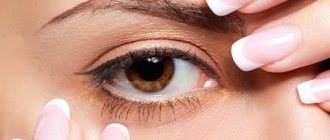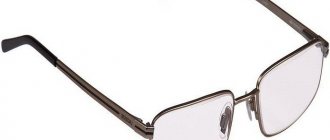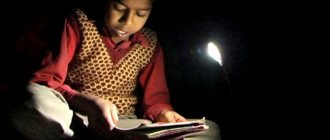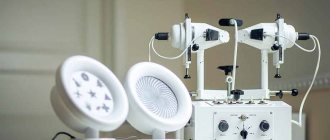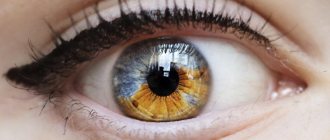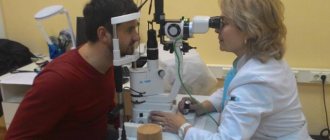Reasons: why does accommodation spasm occur?
The main causes of accommodation spasm are excessive or improperly organized visual stress, lack of lighting, severe eye fatigue (long-term work at the computer, reading, working with optical instruments and small parts at close range).
Among the secondary reasons are malnutrition, vitamin deficiencies, disturbances in sleep and wakefulness, lack of physical activity necessary to maintain health, weakness of the back and neck muscles, the consequence of which is incorrect posture, leading to insufficient blood supply to the brain and visual system.
Optometry for dummies. Reserve (stock) of accommodation.
Accommodation reserve is the force of accommodation remaining in reserve, not required when working close. Why do we need to know about this? The fact is that the eyes can work for a long time without strain only if the reserve of accommodation is twice as large as the part expended. With the help of certain exercises described in this article, the reserve of accommodation can be trained. Relative accommodation is usually characterized by volume. And they measure it in diopters - using trial lenses from the kit. Relative accommodation has two parts: positive and negative. The negative part is the accommodation that we spent in order to clearly see any object; we determine it by the method of neutralization with positive glasses: we look at some object and put positive glasses to our eyes, intensifying them until the object begins to blur. The strength of the glasses, in which the object is still clearly visible, will show the amount of accommodation expended. The positive part is the reserve of accommodation, that is, the amount by which the ciliary muscle is still capable of contracting, in other words, the reserve. It is determined in the same way as the negative part, only negative lenses are placed on the eyes. Accommodation reserve is the force of accommodation remaining in reserve, not required when working close. Why do we need to know about this?
The fact is that the eyes can work for a long time without strain only if the reserve of accommodation is twice as large as the part expended. This means that during intense accommodation, there should be twice as much in reserve as we strained, so that the eyes do not get tired. This, in my opinion, is the most important thing in optometry. Example: let's say, you can lift a load weighing 40 kg from the floor, but can you carry it at least a meter? And you can carry 10 kg for half a day without any special problems. So it is with accommodation. To read for a long time or sit in front of a computer without problems, the supply of accommodation (reserve) must be twice as large as the part expended. This reserve is maximum at 15 years - 5 diopters, then it gradually decreases. Let's do some math. Usually the closest point of clear vision for an emmetrope is about 10 cm in front of the eye. Consequently, the hollow volume of relative accommodation is 10.0 D. If you hold a book at a distance of 30 cm, 3.5 D are spent (I am rounding), the reserve is 6.5 D. The 1:2 ratio is preserved, you can read for as long as you like. That is why it is recommended to keep the book no closer than 30 cm to your eyes. Closer - already tense. By the way, it has been proven that myopia in first-graders begins with a low head tilt. An article by Avetisov E.S. has been published. et al., in which it was mathematically proven that there is a group of children who are more comfortable working while bending low over the table (what is called the “nose”), despite the overstrain of accommodation. Therefore, they develop myopia. And it is useless to scold such children; they themselves do not notice how their heads droop. I can share my experience: I teach children to support their heads with their hands. All teachers teach children to hold a notebook with one palm and write with the other, and scold them when they prop their heads up. But I teach exactly the opposite. We place our elbow on the notebook to hold it, our palm under our chin, and write with the other hand. As a result, the child cannot lower his head - the elbow holds him in place, there is no overstrain of accommodation. The reserve of accommodation must always be taken into account when we select glasses. Now the question is: how often do ophthalmologists do this? Right! This is why myopia progresses, this is why glasses are not suitable, this is why you can’t see well without glasses, and why your head starts to hurt with glasses. Ideally, each child should have their accommodation reserve determined before school, and if it is below normal, be given weak reading glasses at the same time as ciliary muscle training. When I started checking the accommodation reserve of first-graders, I was surprised how many of them had zero reserve. Just imagine - there is no reserve at all, the ciliary muscle works with full strength, as if you were forced to carry a barbell with you. This is where myopia begins. And now the computer is adding problems, which is why there is some kind of surge in myopia among schoolchildren. When choosing glasses for nearsighted people, it is necessary to determine the reserve of accommodation using distance glasses. If it is below normal, a person wearing these glasses will not be able to work at close range, the ciliary muscle will be overloaded. The result is progression of myopia. In case of hidden farsightedness, when there is a habitual accommodation tone that maintains focus on the retina when looking into the distance, it is necessary to determine the reserve of accommodation without glasses to make sure that reading glasses are not needed, otherwise headaches, heaviness in the eyes and brow ridges, and blurring of the text are guaranteed. By the way, in practice, the negative part of accommodation is rarely determined. I mainly focus on the age norm of accommodation reserve. At 7 years old, the reserve of accommodation should be at least 3 D, at 11 years old - at least 4 D, at 15 years old - 5 D. This is the maximum, then somewhere from 18-20 years old, the reserve of accommodation begins to gradually decrease due to the loss of elasticity of the lens , But that is another story. And in conclusion , a logical question: is it possible to increase the reserve of accommodation? The answer is categorically affirmative - you can! And it is necessary! This is done simply: with daily exercises. With daily training, the reserve of accommodation can be increased to 6-7 D in 2 months; I have observed this in my patients. If my myopic patient with glasses has an accommodation reserve of at least 5 D, I prescribe glasses for him in his pocket: wear them if you want, don’t wear them if you don’t, but just be kind enough to do exercises with glasses every morning and evening! Myopia in such cases does not progress - verified! My method of exercise: we find a room or corridor at least 5 m long, hang some landmark on the end wall (a clock, a picture, put up a sculpture - it doesn’t matter, as long as the eye has something to catch on to), sit down at the opposite wall and pick it up book. Now we read 2-3 words, look at the opposite wall, read again, again at the wall - 5 minutes in the morning and evening. A necessary condition is to do the exercises with distance glasses. Children should definitely be forced to read aloud; this is the only way to ensure that they really focus on the text. Children are very smart people; when you allow them to read to themselves, they stop straining their ciliary muscles, and then their parents wonder why the training is of no use. At one time, my children were prescribed similar exercises with a mark on the glass (look at the mark - behind the glass - at the mark). This is a generally accepted technique developed in the department of vision protection of the Institute. Helmholtz. I couldn’t organize the exercises in this version: there’s no time in the morning, you’re all running around, you barely have time to feed them; at lunchtime they didn’t do these exercises without me; and when I came home from work, it was already dark outside the window - there were no landmarks. So my technique is hard-earned. By the time I realized that I could train indoors, my eldest’s myopia increased by 1D. But then the supply grew to 7D, I stopped controlling whether she wore glasses and until the end of school we kept this 1D! I even allow older child patients not to allocate a fixed time for training. These workouts can be done during the day when you have free time. For example, if you are traveling in a minibus, sit by the window and practice (on the glass - behind the glass); if you are talking with a friend, practice quietly (on her face - behind her face), while waiting for the bus - practice (on your hand - into the distance, look for the bus number), etc. Such constant training, when you remember, gives more effect than twice a day for five minutes. And I also noticed: in myopic people, even when a good reserve of accommodation is achieved, if you stop training, it inevitably decreases. You have to train every day! But myopia does not progress! Published with permission from Dogatova E.I. - Assistant of the Department of Ophthalmology of Dagestan Medical. Academy, candidate of medical sciences.
Causes of accommodation spasm (false myopia) in children
Children of preschool and primary school age are at risk of developing a spasm of accommodation more than others. This is due to the fact that the child’s visual system is being restructured at this time and is in a phase of active development.
The main causes of accommodation spasm in schoolchildren:
- excessive visual stress (TV, computer, tablet, phone);
- doing homework in the evening and at night;
- poor workplace lighting;
- non-compliance with the daily routine (lack of walks in the fresh air, exercise, lack of sleep);
- the desk and chair do not match the child’s height;
- failure to maintain the optimal distance to the book (30–35 cm);
- weakness of the neck and back muscles;
- impaired blood supply to the cervical spine;
- poor nutrition, hypovitaminosis;
- insufficient physical activity.
Loss of the ability to accommodate with age
One of the conditions for normal accommodation is the elasticity of the lens . With age, it decreases, the lens becomes denser and harder.
The lens has the best accommodative properties in childhood. Then, due to the aging process and changes in the biochemistry of the body, the ability to see well up close gradually decreases (usually after 40–45 years), and presbyopia develops - age-related farsightedness. This is a natural and irreversible process; vision can be restored in the case of developing presbyopia only with the help of optical correction, implantation of a phakic lens, or replacement of the lens with an intraocular lens.
Accommodation indicators
The accommodative ability of the eye is expressed in diopters or linear values.
Accommodation indicators obtained from examining each eye separately are called absolute. And both at once are relative, since they are performed with a certain convergence (reduction) of the visual axes.
- The area of accommodation is the distance between the farthest (distance vision) and the nearest (near vision) points of clear vision.
- The volume of accommodation is the difference in the refractive index of the eye (in diopters) when set to the nearest and farthest points of clear vision.
- The accommodation reserve is the unused part of the accommodation volume (in diopters) when the eye is placed at the fixation point.
Subjective methods
In foreign literature, regardless of whether the test is performed binocularly or monocularly, the term “amplitude of accommodation” (AA)
.
Domestic authors prefer the term “volume of absolute accommodation” (VAA)
, meaning by it the difference in the refraction of one eye when focusing on the nearest and further points of clear vision, expressed in diopters. It is believed that to obtain a more accurate result, the other eye should be covered during the test so that convergence and miosis do not distort the result.
The binocular amplitude of accommodation is indeed greater than the monocular amplitude by 0.30-0.60 diopters,7-9,11 but there is no consensus on the methodology either among researchers12 or among the authors of textbooks - some advise taking measurements monocularly,3,4 others - as mono - so is binocular.5,6
It is believed that binocular measurement more accurately reflects the state of accommodation in everyday life - therefore, if there is no need to specifically test one eye, in clinical practice the amplitude of accommodation is usually measured binocularly using the push-up method.12 An exception is the minus lens method, which gives an accurate result only when monocular testing.
Push-away
To determine TOA, near test objects corresponding to visual acuity of 0.7-1.0 or the Duane figure are used.
Under conditions of full correction for distance, the test object is slowly moved away from the eye until the moment of discrimination, i.e., the nearest point of clear vision (CPV) is found in centimeters and this value is converted into diopters: OAA (diopter) = 100 ÷ CPCL (cm). 1-6
Push-up
This method differs only in the direction of movement of the target - the test object should be brought closer to the patient until the moment of stable blurriness, and then the TAA is calculated using the above formula.3-6
Minus lens
The minus lens method requires maintaining precise distance to the optotype throughout the test, so it must be performed using a phoropter. An accurate result can only be obtained with monocular testing.
Before starting the test, the full distance correction is set in the phoropter, and the test object is placed in front of the patient's eye. Then, in increments of 0.25 D in 1-2 seconds, minus lenses are added until the moment of stable blurriness. The difference between distance correction and final lens power will indicate the amplitude of accommodation.3-6
How to avoid mistakes?
Despite the apparent simplicity of the methods, none of them have yet been standardized. Therefore, in 2020, British optometrist David H. Burns and a group of co-authors published an article about the causes of errors during the measurement of amplitude of accommodation and gave some tips for eliminating them.12
Recommendations for push-up and push-away methods:
- the movement of the optotype should be slow - approximately one diopter per second [if you mark the ruler in diopters, it will become obvious that the speed should decrease as you approach the patient]
; - During measurement, contact should be maintained with the patient to encourage his efforts to focus on the optotype;
- the ruler and optotype should be held in the direct direction of gaze [the difference between a direct gaze and a downward gaze can be up to 3.50 diopters5]
; - the measurement should be carried out with a clear reference point, such as the apex of the cornea [in the literature, less obvious landmarks are often found - the eye, the corner of the eye, 14 mm from the eye, the plane of the frame or lens]
; - any correction of refractive error must be applied to the same point [meaning correction for distance - if you take the apex of the cornea as a reference point, and refer to Duane's standards (his reference point was located 14 mm in front of the eye), then you must make vertex correction13]
; - in a push-up test, the end point should be the first slight but persistent blur;
- in a push-away test, the end point should be a clear focus;
- Consider taking the first push-up measurement and then moving the optotype away from the patient to obtain a push-away measurement; the average of these two values will be the amplitude of accommodation.
Recommendations for the minus lens method:
- the test object should be located as close to the eyes as possible;
- Lens power should be changed slowly.
Forms of accommodation disturbance:
- spasm of accommodation;
- asthenopia;
- paralysis of accommodation;
- age-related weakening of accommodation (presbyopia).
Accommodative asthenopia
In other words, this is chronic fatigue of the muscles responsible for accommodation. Most often, the pathology develops in people with farsightedness, astigmatism, or in the absence or incorrectly selected glasses correction.
Patients complain of rapid eye fatigue when reading, blurred book text, redness of the eyes and edges of the eyelids, burning sensation, itching, foreign body sensation, headache, episodes of nausea and vomiting.
The main cause of accommodative asthenopia is excessive strain of accommodation near, while its reserves are limited. Treatment of pathology is optimal spectacle or contact correction.
Paralysis and paresis of accommodation
As a rule, these conditions are neurogenic in nature or occur as a result of injury or poisoning. In people with normal visual acuity and farsighted people, near vision deteriorates. In myopic people, visual acuity does not drop so sharply, and sometimes does not change at all. With paralysis, the volume of accommodation is reduced and its reserves are lost.
Age-related weakening of accommodation (presbyopia)
A physiological phenomenon that is associated with age-related changes in the lens, its hardening and gradual loss of elasticity. Treatment is the selection of optimal correction for near vision in accordance with age and initial refraction.
Accommodation research method
Violations in the mechanism of accommodation can be determined by carrying out the accommodometry procedure , with which it is possible to determine indicators of both absolute and relative accommodation.
In the first case we are talking about the sharpness of vision of each eye individually, and in the second we mean the combination of the left and right eyes.
The procedure also helps to establish the degree of eye performance and identify visual fatigue , and based on the results of the examination, the ophthalmologist can not only determine the cause of the disorder, but also prescribe adequate treatment.
